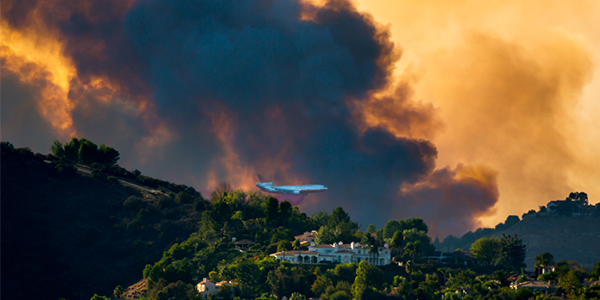By Hudson Sangree
SACRAMENTO, Calif. — Gov. Gavin Newsom signed a bill Friday that’s intended to shore up California’s investor-owned utilities against wildfire liability.
Newsom pushed lawmakers to quickly pass Assembly Bill 1054, which they did in less than a week after it was amended to reflect the governor’s wildfire plan. It takes effect immediately as an urgency measure.
“I want to thank the Legislature for taking thoughtful and decisive action to move our state toward a safer, affordable and reliable energy future,” the governor said in a statement after the Assembly gave the bill its final approval Thursday. “The rise in catastrophic wildfires fueled by climate change is a direct threat to Californians.”
The bill does not give utilities the relief from California’s strict liability standard, known as inverse condemnation, that they wanted. But it creates a $21 billion fund to pay for wildfire damages, to be bankrolled equally by ratepayers and the state’s three large investor-owned utilities.
Under the measure, the IOUs could opt in and contribute an initial $7.5 billion in aggregate and pay $3 billion more over the next 10 years. Pacific Gas and Electric, Southern California Edison and San Diego Gas & Electric would cover 64.2%, 31.5% and 4.3%, respectively, based in part on the size of the utilities and the miles of power lines that run through high-fire-risk areas.
Ratepayers would fund their $10.5 billion share through charges on electric bills, averaging a few dollars per month.
Elected officials hope the fund will head off further downgrades by credit rating agencies of SCE and SDG&E and alleviate concerns those utilities, like PG&E, could wind up in bankruptcy.
(The bill allows utilities to opt for a $10.5 billion state-backed line of credit in lieu of the wildfire fund. They must choose within 15 days. The general belief is they will opt for the wildfire fund.)
PG&E filed for bankruptcy in January, citing billions of dollars in wildfire liability from November’s Camp Fire, the deadliest in state history with 85 fatalities, and a series of devastating blazes in 2017.
SCE’s equipment is suspected of starting the Woolsey Fire, also in November 2018, which killed three people and destroyed more than 1,600 structures. The utility also faces massive liability for 2017’s Thomas Fire, which it admitted may have been sparked by its equipment. That fire killed two people, while ensuing mudslides caused by rain drenching charred hillsides caused 21 deaths. (See Edison Takes Partial Blame for Wildfire in Earnings Call.)
SCE and SDG&E each had their credit ratings downgraded, although the latter hasn’t had a significant utility-sparked fire in years, since it began a major grid hardening effort that’s often citied as a model.
Stabilizing California
Those who supported the bill said bolstering the utilities against insolvency would allow fire victims to be compensated more quickly and maintain stable rates for customers.
“We’re talking about victims, ratepayers and the industry that keeps the lights on,” said Assemblyman Chris Holden, one of the bill’s three co-authors and chairman of the Assembly Utilities and Energy Committee.
The measure requires PG&E to exit bankruptcy by June 30, 2020, and pony up its share of the initial $7.5 billion before it can recoup costs from the wildfire fund.
It also requires the IOUs to pay a combined $5 billion for fire-safety upgrades without recouping profits from ratepayers through a return on equity.
Assemblywoman Eloise Reyes said she struggled with the bill but decided to vote “yes” because she felt it would compel PG&E to leave bankruptcy and prioritize safety, while stabilizing electric service and rates in California.
“In the end our job is to stabilize California,” Reyes said.
While speakers on the Assembly floor Thursday generally praised the bill and urged its passage, others remained troubled.
Assemblyman Al Muratsuchi, a Los Angeles-area Democrat, asked “whether we could have done better if we had more than two weeks” to weigh the measure. The bill, in its current form, was first printed two weeks ago and then heavily amended July 5 over the holiday weekend.
It cleared two state Senate committees Monday before being passed by the upper house, all in a matter of hours. (See Calif. Lawmakers Rush to Pass Utility Wildfire Aid.)
Last year, lawmakers hastily passed Senate Bill 901, another major wildfire bill, under pressure from then-Gov. Jerry Brown and legislative leaders. They were told if they didn’t pass the bill, PG&E would go bankrupt, which it did anyway.
“Now we’re being asked to pass this bill, and if we don’t pass it [by July 12] according to the governor … then Edison is going to be downgraded to junk bond status and may face bankruptcy,” Muratsuchi said. He questioned whether the utility would follow the same course as PG&E.
Assemblyman Marc Levine, a Democrat who represents a district north of San Francisco, voted “no” on the measure and said it was not right to offer PG&E assistance when it had yet to upgrade its power lines to prevent fires.
The Caribou-Palermo transmission line that sparked the Camp Fire was 100 years old, and maintenance had been deferred repeatedly, leading to 85 deaths, he said. Other PG&E lines in high-risk areas may be in similar condition, he said.
“It is hard not to see this bill as a reward for monstrous behavior,” Levine told his colleagues. “They have not done the work. They should not be rewarded.”





